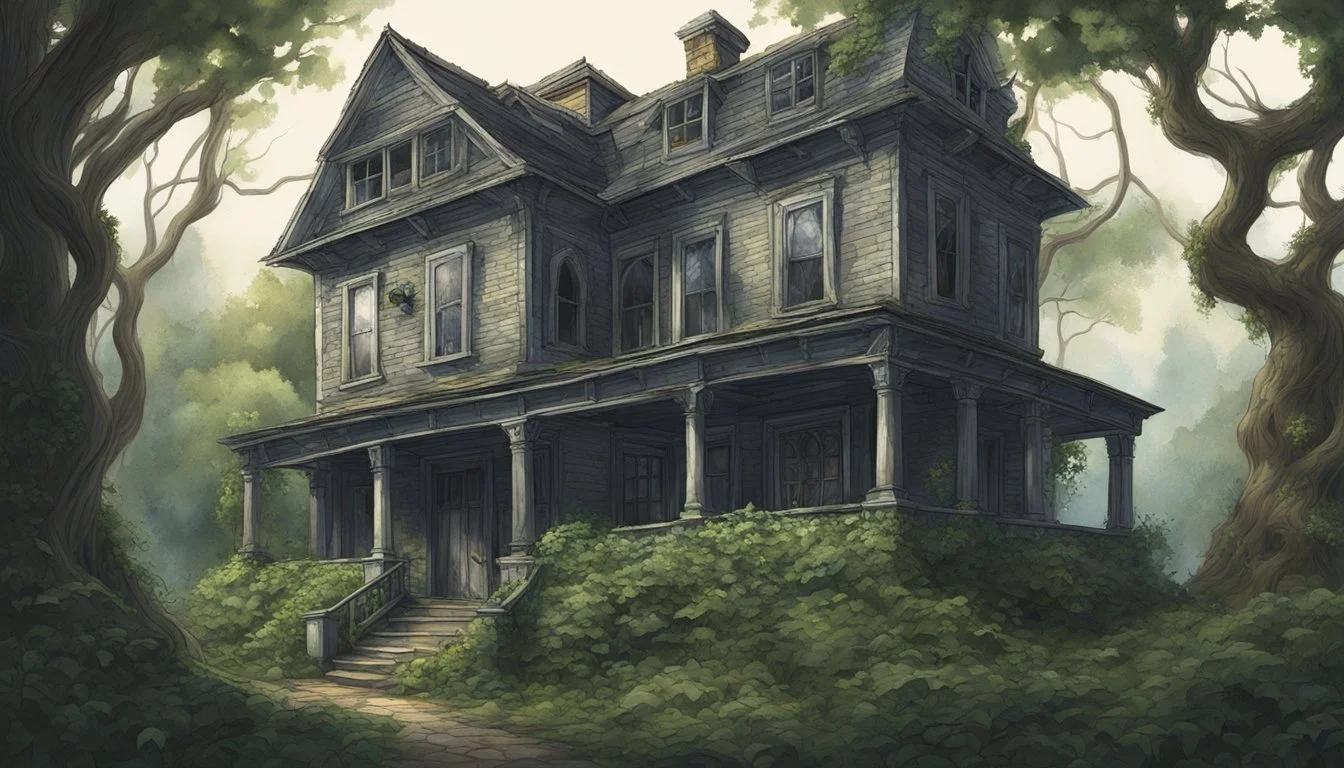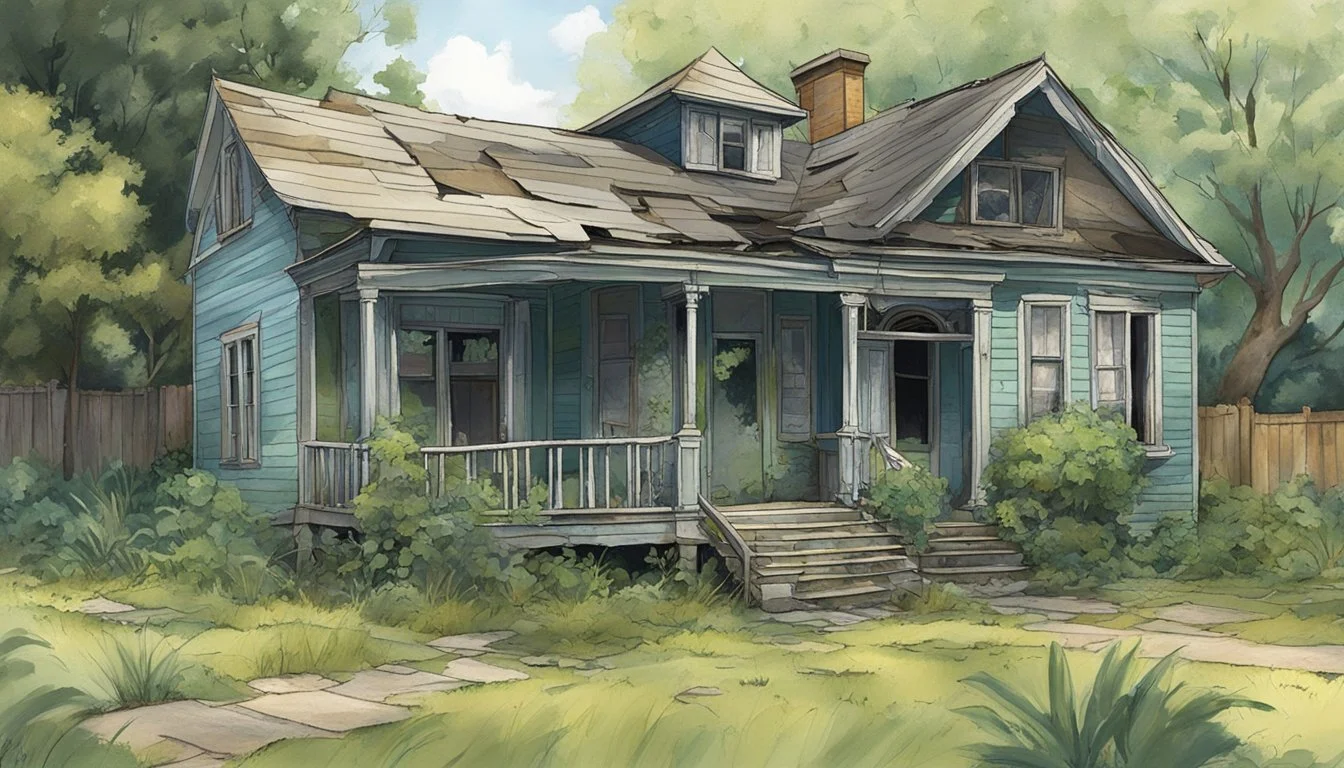The Significance of Walt's Home: From Haven to Hell
A Symbol of Transformation in Breaking Bad
Walter White's home in Breaking Bad undergoes a dramatic transformation, mirroring his descent into the criminal underworld. Initially a symbol of suburban normalcy, the house becomes tainted by Walt's illicit activities and moral decay. As Walt's actions spiral out of control, his once-peaceful abode transforms into a physical representation of the chaos and destruction he has wrought.
The chalk drawing of a scythe outside Walt's house in season 3 foreshadows the death and ruin that will soon engulf his family life. This ominous symbol marks a turning point, signaling that Walt's actions will have far-reaching consequences beyond his control. By the series finale, Walt's home lies abandoned and dilapidated - a stark reminder of the cost of his choices.
Through clever visual storytelling, the creators of Breaking Bad use Walt's house to reflect his character arc. The gradual deterioration of his home parallels Walt's loss of integrity and humanity. From a place of comfort and safety, it evolves into a site of danger and moral corruption, ultimately becoming an empty shell devoid of the warmth and love it once contained.
Walt's Transformation
Walter White undergoes a profound metamorphosis throughout Breaking Bad. His journey from a mild-mannered chemistry teacher to a ruthless drug lord is marked by significant changes in his personality, actions, and moral compass.
The Metamorphosis of Walter White
Walt starts as a high school chemistry teacher struggling to make ends meet. His cancer diagnosis acts as a catalyst, pushing him to enter the dangerous world of meth production. Initially, Walt's motives seem noble - providing for his family after his death.
As he delves deeper into the drug trade, Walt's skills as a chemist shine. His meth achieves unprecedented purity levels, earning him respect and notoriety in the criminal underworld. This recognition fuels Walt's ego and ambition.
Walt's transformation is also physical. He shaves his head and grows a goatee, symbolizing his departure from his old life. His fashion choices evolve, culminating in his signature pork pie hat and dark sunglasses.
Walt as Heisenberg: The Birth of a Villain
The persona of Heisenberg emerges as Walt's alter ego. This new identity allows him to embrace darker aspects of his personality, previously suppressed by societal norms. Heisenberg is confident, ruthless, and unapologetic - everything Walter White was not.
As Heisenberg, Walt commits increasingly violent and morally reprehensible acts. He manipulates, lies, and kills to protect his empire. The writers of Breaking Bad masterfully portray this gradual erosion of Walt's morality.
Walt's transformation challenges viewers' perceptions of good and evil. The once sympathetic character becomes a villain, forcing audiences to question their own moral boundaries. This complex character development is a key factor in Breaking Bad's critical acclaim.
Family Dynamics and Turmoil
Walt's home transforms from a sanctuary to a battleground as his secret life unravels. Family relationships deteriorate amid lies, betrayal, and conflicting loyalties. Tensions rise as each family member grapples with the fallout of Walt's choices.
Skylar's Conflict and Despair
Skylar White faces immense turmoil as she uncovers Walt's criminal activities. Her initial shock gives way to anger and fear for her family's safety. She struggles to maintain a facade of normalcy while grappling with her husband's deception.
Skylar's attempts to protect her children lead to difficult choices. She becomes complicit in Walt's money laundering, further straining their relationship. Her emotional state deteriorates, manifesting in bouts of depression and anxiety.
The once-loving partnership crumbles under the weight of secrets and mistrust. Skylar's home no longer feels safe, becoming a constant reminder of her family's precarious situation.
The Role of Walt Jr. and Family Cohesion
Walt Jr., unaware of his father's true nature, becomes caught in the crossfire of his parents' deteriorating relationship. He senses the tension but struggles to understand its source. His loyalty shifts between his parents as he tries to make sense of their changing dynamic.
The teenager's cerebral palsy adds another layer of complexity to family interactions. Walt Jr. often serves as a buffer between his parents, unknowingly easing tensions through his presence.
As the family unit fractures, Walt Jr. clings to moments of normalcy. Family dinners become rare occasions of forced civility, highlighting the stark contrast to their once-harmonious household.
Hank's Pursuit and the Ultimate Betrayal
DEA agent Hank Schrader's relentless pursuit of "Heisenberg" unknowingly puts him on a collision course with his brother-in-law. His investigation strains relations within the extended family, creating an atmosphere of suspicion and unease during gatherings.
Hank's discovery of Walt's true identity shatters the foundation of trust between them. The betrayal cuts deep, transforming their once-close relationship into one of animosity and fear.
The fallout affects Marie, Hank's wife and Skylar's sister, further complicating family dynamics. Loyalties are tested as the Schraders and Whites find themselves on opposite sides of the law.
The Symbolism of Walt's Home
Walt's house transforms from a cozy family residence to a symbol of his moral decay and shattered relationships. The changing nature of his home reflects Walt's internal journey and the consequences of his choices.
From Sanctuary to Warzone
Walt's home initially represents safety and normalcy. The modest suburban house shelters his family and embodies his role as a responsible father and husband. As Walt descends into the drug trade, his home gradually loses its warmth and security.
The once-pristine living room becomes a battleground of tension and secrets. Family dinners turn into uncomfortable silences. Walt's bedroom, once shared with Skyler, becomes a solitary space as their marriage crumbles.
The garage, where Walt first hid his drug money, symbolizes the intrusion of his criminal life into the domestic sphere. The crawl space under the house, where Walt laughs maniacally upon discovering his money is gone, represents his mental breakdown and loss of control.
Literary References and Home Significance
Walt Whitman's "Leaves of Grass" plays a crucial role in connecting Walt's home to his fate. The book, gifted by Gale Boetticher, sits on Walt's nightstand as a reminder of his alter ego and criminal pursuits.
This literary presence foreshadows Walt's downfall. Just as Whitman's poetry celebrates the self, Walt's home becomes a reflection of his inflated ego and moral corruption. The contrast between Whitman's idealistic verses and the deteriorating household highlights Walt's departure from his former values.
The pool in Walt's backyard serves as a poetic metaphor for his internal struggles. It becomes a site of significant events, including Skyler's attempt to "drown" herself, symbolizing the family's suffocation under Walt's choices.
Chemical Bonds: Partnerships in Crime
Walter White's journey into the criminal underworld was marked by key alliances that shaped his transformation into Heisenberg. These partnerships blended chemistry, ambition, and moral compromise.
Jesse Pinkman: More Than a Partner
Jesse Pinkman started as Walt's former student and became his right-hand man in the meth business. Their partnership was volatile yet essential, with Jesse providing street smarts and connections. Walt saw potential in Jesse, often pushing him to improve his skills.
Their relationship evolved from teacher-student to a complex father-son dynamic. Jesse's loyalty was tested repeatedly, especially as Walt's actions grew more ruthless. Despite conflicts, their chemistry knowledge and complementary skills made them a formidable team in the drug trade.
Gale Boetticher and the Price of Knowledge
Gale Boetticher represented the intellectual side of meth production that appealed to Walt. A fellow chemist, Gale admired Walt's formula and expertise. Their partnership was brief but significant, highlighting Walt's desire for recognition.
Walt's decision to have Gale eliminated showcased the dark turn in his moral compass. This act emphasized how far Walt would go to protect his position and interests in the drug world. Gale's death marked a crucial point in Walt's descent into villainy.
Saul Goodman: Legality Meets Morality
Saul Goodman, portrayed by Bob Odenkirk, brought legal expertise to Walt's illegal enterprise. As a criminal lawyer, Saul provided crucial advice and connections that kept Walt's operation running. His colorful personality and questionable ethics complemented Walt's growing disregard for the law.
Saul's role expanded beyond legal counsel, often acting as a fixer for Walt's problems. Their partnership showed how Walt navigated the complexities of the criminal world, blending Saul's street-smart approach with his own calculated methods. Saul's involvement deepened Walt's entanglement in the drug trade's darker aspects.
The Landscape of Crime
Albuquerque's unique blend of urban and desert environments created the perfect backdrop for Walt's descent into the criminal underworld. The city's reputation as a hub for methamphetamine production and distribution played a crucial role in shaping the narrative.
Albuquerque: The Meth Capital
Albuquerque earned the nickname "Meth Capital" due to its high rates of methamphetamine production and use. The city's vast desert areas provided isolated locations for clandestine drug labs. Urban neighborhoods offered cover for small-scale operations.
Law enforcement struggled to combat the widespread meth problem. The DEA estimated that Albuquerque supplied a significant portion of the U.S. meth market. This reputation made the city an ideal setting for Walt's transformation into a drug kingpin.
The Drug Trade and Its Mechanics
The meth trade in Albuquerque operated through a complex network of manufacturers, distributors, and dealers. Large-scale producers like Walt relied on a chain of middlemen to move their product.
Key components of the trade included:
Precursor chemical acquisition
Clandestine lab operations
Distribution networks
Money laundering schemes
Violence often erupted between rival factions vying for control of territory and resources. The high stakes and ruthless nature of the business pushed Walt further into the role of villain, leading to numerous deaths and a trail of destruction across the city.
Legacy and Impact
Walt Disney's influence extends far beyond his lifetime, shaping popular culture and raising profound questions about morality and redemption. His work continues to captivate audiences and spark debates decades after his passing.
A Series' Influence on Popular Culture
Walt Disney's creations have become deeply ingrained in society. Mickey Mouse remains an iconic symbol recognized worldwide. Disney films have shaped generations, influencing fashion, music, and language. Theme parks like Disneyland set new standards for immersive entertainment experiences.
Disney's storytelling techniques revolutionized animation and filmmaking. His emphasis on family-friendly content established a benchmark for wholesome entertainment. This approach influenced other creators, including those behind shows like Lost, which blended mystery and moral dilemmas in a format accessible to wide audiences.
Walt's Endgame: The Question of Redemption
Walt Disney's legacy is complex, sparking debates about his personal views and business practices. Critics argue that some early Disney works contained problematic stereotypes. Others praise his artistic vision and entrepreneurial spirit.
The question of redemption looms large in discussions of Walt's legacy. Some compare this to themes explored in Breaking Bad, where characters grapple with morality and the possibility of redemption. Walt's later philanthropic efforts and educational initiatives are often cited as attempts to leave a positive impact.
Disney's influence on American culture is sometimes likened to that of historical figures like Abraham Lincoln, both leaving indelible marks on the nation's identity.
Conclusion
Walt's home transforms from a sanctuary to a symbol of his downfall. It reflects his journey from mild-mannered chemistry teacher to ruthless drug kingpin.
The house begins as a safe haven for the White family. It represents Walt's ordinary life and middle-class aspirations. As his criminal activities escalate, the home's meaning shifts dramatically.
By the series finale, the once-tidy residence lies in ruins. Graffiti covers the walls and squatters occupy the empty rooms. This decay mirrors Walt's shattered relationships and lost humanity.
The pizza on the roof stands out as an iconic image. It encapsulates the chaos Walt brought into his domestic life. His home becomes a physical manifestation of the destruction left in his wake.
Ultimately, Walt's house embodies his rise and fall. It tells the story of a man who sacrificed everything - family, morality, and his very soul - in pursuit of power and recognition.







